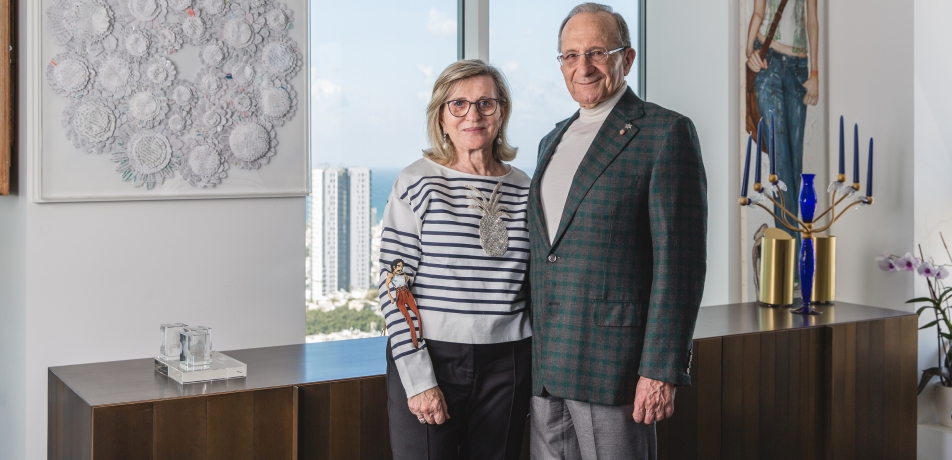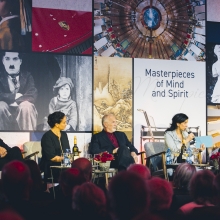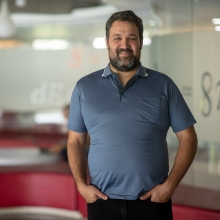Sami and Tova Sagol
Furnishing the future of science
People behind the science

When Sami Sagol was a high school student in Tel Aviv, he dreamt of being a scientist. It was 1962, and his school, a melting pot for new immigrants with few resources to challenge the most curious students, didn’t quench his thirst for science. So he hopped on a bus to the Weizmann Institute of Science on a regular basis, where he took part in a youth program in which the Institute’s investigators, including Prof. Michael Sela and Prof. Efraim Katchalski (Katzir)—then in the early years of their careers—lectured about their research and other areas of science.
Sami ultimately went in another direction, to business, becoming the CEO of the highly successful global company Keter Plastic. But he has come full circle, back to the Weizmann Institute as a philanthropist, where he and his wife Tova are now deeply engaged in advancing the future of brain science. Their most recent gift, which establishes the Sagol Institute for Longevity Research, was celebrated at the latest International Board meeting in November. The Sagol Institute will explore a vast range of factors that are associated with extending the human life span, including treating neurodegenerative diseases, cardiovascular disease, metabolism, and nutrition. The Institute is one of a long list of gifts to Israeli institutions comprising the Sagol Neuroscience and Longevity Network, a series of 12 centers at eight Israeli institutions doing research and clinical care in brain science, aging, and longevity.
“It amazes me to think that all those years ago I learned science from Michael Sela, and today he is my good friend,” says Sami. “And because the Weizmann Institute is synonymous with excellence and innovation and attracts the best scientists, I feel proud to have re-found my place at the Weizmann Institute, and to be associated with it all these years later.”
From Izmir to Israel
Sami was born in 1942 in Izmir, Turkey, a city once known as Smyrna, on the country’s Aegean coast. “At age six,” he recalls, “I started to hear the first talk at home about Zionism and the establishment of the Jewish state… In 1948, several of my father’s friends moved to Israel and my father, Yosef, helped them by investing in their fledgling company.” They named their company Keter (Hebrew for “crown”), selling simple plastic items like soapboxes and combs from a two-room building in Jaffa.
While close to half of Turkey’s Jewish population left for Israel after its establishment, the Sagol family stayed put in Turkey for the time being. Yosef Sagol ran a small but thriving textile business and was in no hurry to leave. Sami went off to an American boarding school in Istanbul. But after Israel’s war with Egypt in Sinai in 1956, Sami made aliya alone, at age 15. His parents and siblings came a year after him, and his father joined his friends in running the plastics business in Jaffa.
“That first year in Israel was very difficult,” he recalls. It seemed a natural choice to enroll in the Anglican School in Jaffa, but he soon felt the absurdity of having come on aliya to land in a Christian missionary school. But he didn’t know Hebrew, and he was at a critical age when students were beginning to take their high school matriculation exams. And so he found himself roaming Tel Aviv’s streets, knocking on school doors and asking to enroll. “No school would take me in,” he says. Finally, one did, Geula High School. “It wasn’t a great school, but for me, it was a gift.”
After graduating, he joined the prestigious Atuda program of the Israel Defense Forces, which enables high school graduates to defer the draft until after university studies and do army service in their area of expertise. He studied chemical engineering at the Technion.
He and Tova met during his army service. Tova was from Netanya; she was born in an Italian transit camp to parents who were Holocaust survivors, and came to Israel at age one.
After Sami graduated from the Technion, he and Tova planned to move to the U.S. so that he could pursue graduate studies at MIT. But the small company in Jaffa was in decline and on the brink of closure, and Yosef Sagol asked his son to try to turn it around, so they agreed, and stayed. And turn it around he did, together with his brother Itzhak, based on a few simple but innovative premises: people like to sit outside, especially in Israel’s moderate climate where there is a culture of eating and sitting outdoors; they don’t want to ruin their indoor furniture; and they won’t spend on the outdoors what they will on the indoors. And so the brothers changed the product to light, aesthetic, and inexpensive garden furniture, bought up competitors, and watched what international companies were producing—and then figured out how to use new technologies to make the products in a more inexpensive way.
One of the secrets to the company’s success was prioritizing innovation, says Sami. He established something previously unheard of within a commercial entity: its own degree program. Together with Bezalel Academy of Arts and Design and Shenkar, Israel’s two leading art and design schools, Keter launched its own in-house training school for product designers and engineers, where they learned to be creative and thrifty with plastics. Over the course of several decades, Keter became the number-one garden furniture and home improvement products company in Israel and then one of the world leaders in the field.
Today, Keter has more than 4,000 employees, 18 manufacturing plants, and advanced distribution centers in nine countries. In 2010, Sami started to realize that in order to maintain Keter Group’s growth, the business would require new ownership and management. In 2016, the Sagol family sold its majority stake in Keter for a transaction valued at $1.7 billion. The Israeli business newspaper Globes named Sami ‘Person of the Year’ that year.
Children and innovation
Tova and Sami, who previously lived in Ramat Hasharon and raised their four daughters there, now live in Tel Aviv. They relish the sweeping view from their 30th floor apartment, where the city—and its visible, rapid transformation from low-slung apartment buildings to high-rises—is spread out below, with the Mediterranean Sea a beautiful blue expanse just beyond.
After Keter’s sale, “my second career began,” Sami jokes. But the Sagols’ philanthropic work, which he is referring to, is serious stuff. At the Weizmann Institute, the Sagols have given generously to various areas, including Davidson Online, the website of the Davidson Institute of Science Education. Today, Davidson Online has become a go-to source for science news in Hebrew for schoolchildren, teachers, and the broader public, and serving as a model for online science literacy.
But Sami is investing his greatest efforts today in expanding his Sagol Neuroscience and Longevity Network, which, he says, “became a dream of mine after both of my parents died from brain diseases—my father from Alzheimer’s and my mother from a stroke.”
One of the research areas in which Sami and Tova feel most passionate about is the use of hyperbaric medicine for treatment of brain diseases and disorders. The Sagol Center at Assaf Harofeh Medical Center is now considered a world leader in the field, treating more than 120 patients per day, “and is seeing amazing results for the neurological cases and in particular brain injuries and fibromyalgia,” says Sami.
Tova is equally busy with additional philanthropic endeavors. She is the founder of Nitzan Horim, a project she developed within the Nitzan Association, which assists children with disabilities. Nitzan Horim is a unique initiative that helps parents with disabilities care best for their children. She served as President of the Association for many years and today is Chair; her initial involvement began nearly three decades ago, when she sought assistance for one of their daughters, Mia, when Mia became a parent.
In 2016, the Weizmann Institute bestowed on Sami an honorary doctorate, recognizing his business acumen and his outsize contribution to Israeli society and science. It was an honor that Sami says brought him “full circle”.
In line with Sami’s business approach of canvassing the Israeli market and then going international, the Sagols’ next major gift to the Weizmann Institute will fund a major multidisciplinary collaboration with MIT. The gift, he hopes, “will not only seed joint research between these two great institutions. I’m dreaming bigger,” he says. “I would like this to be the starting point to seed scientific collaborations between the Sagol Network in Israel and scientists in Massachusetts, another major hub of scientific activity.” And then he has a grander plan that is reminiscent of the way Keter was run by a team of his father and his friends in the company’s early years.
“There is always a grander plan,” smiles Tova.
“I want all my friends to give too, to advance science and make a real difference in the world,” he says, “so that Israel develops a deeper connection with Massachusetts and—when we’re done with that, the sky’s the limit.”
Turning ‘aging’ into ‘longevity’
The Sagol Institute for Longevity Research will be a hub for advancing research on understanding the process of aging and finding ways to solve disorders and diseases in order to allow people to live longer, happier, healthier lives. Here’s a sampling of areas of research that are likely be supported by the Sagol Institute:
Bone health: Prof. Elazar Zelzer and his group in the Department of Molecular Genetics do not have a solution for the elderly falling down and breaking their hips, but they have shed interesting new light on the process that guides the repair of bones. Their research demonstrates the strong and important connection between the nervous system, muscles, and the skeletal framework of the body.
Cellular senescence: Dr. Valery Krizhanovsky in the Department of Molecular Cell Biology is advancing the field of cellular senescence—a cellular state in which cells permanently lose the capacity to divide but do not die. He recently developed a test to estimate the age of individual cells. Since a number of age-related diseases have been shown to be associated with the accumulation of large numbers of senescent cells, his experiments in how to use the body’s natural cell disposal systems have generated much interest, and ongoing research.
Cardiovascular health: Heart disease is a leading cause of death in the world, and so learning to prevent and treat heart diseases is a major key to extending life and improving its quality. Prof. Eldad Tzahor and his team in the Department of Molecular Cell Biology recently identified a molecule associated with growth and development that appears to have the potential to unlock the ability to repair heart muscles but stops functioning after birth.
Neurodegenerative diseases: Solutions for diseases like Alzheimer’s, Parkinson’s, and ALS can come from the oddest places—even spiders’ webs and silkworms. Dr. Ulyana Shimanovich of the Department of Materials and Interfaces has shown parallels between the structure of natural silkworm fibers and the amyloid protein fibers that clog the brains of those with Alzheimer's and Parkinson’s diseases. Her work suggests that amyloid proteins might even have some positive properties, and that understanding how these fibers are produced in nature can suggest ways to control their growth.
Prof. Elazar Zelzer is supported by the Estate of Bernard Bishin for the WIS-Clalit Program; The Kekst Family Institute for Medical Genetics; The Dr. Erhard, Emmi, and Fred Loewinsohn Center for Pediatric Health; The David and Fela Shapell Family Center for Genetic Disorders Research, which he heads; and the Weizmann-University of Manchester Collaborative Projects Program.
Dr. Valery Krizhanovsky is supported by the European Research Council, Mr. and Mrs. Bruce Kanter, and the Rising Tide Foundation.
Prof. Eldad Tzahor is supported by the Dvora and Haim Teitelbaum Endowment Fund; The Yad Abraham Research Center for Cancer Diagnostics and Therapy, which he heads; the Daniel S. Shapiro Cardiovascular Research Fund; the European Research Council; and Pearl C. Vapnek.
Dr. Ulyana Shimanovich is supported by the Ruth and Herman Albert Scholarship Program for New Scientists and the Peter and Patricia Gruber Awards.



The Sagol Center at Assaf Harofeh Medical Center, which is advancing the use of hyperbaric medicine for the treatment of various diseases including brain diseases.








